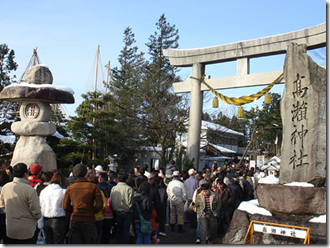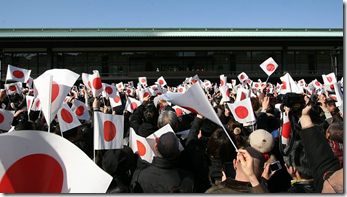英語面白物語-2074:12-31-’18
(Amusing English Story)
Down the hatch!
乾杯!
hatchとは、潜水艦の甲板にある昇降口、ハッチ、水門と言う意味の言葉。感じに想像が付くと思われるが、「ハッチ(口)を大きく開けてきつい酒を注ぎこめ!」と言う海軍の表現であった。・・あった、と言うのは今では女も使う。「さあ、飲みほして!」と言う意味も含むもの。
これは日本語の「乾杯」が、中国語の「杯を乾す」から来ているので、二つの国の言い方によく似ていないこともない。ただ、杯を傾けて一気に飲むと言う情景と、アメリカの、いや、元はイギリス海軍の、言い方は、口を開けて注ぎ込むと言う情景には大した違いはないようだ。18世紀には使われていた。
さて、この英語の、hatchと言う言葉は、イギリス独自の言葉で、古期英語の、haeccから変って来たもの。動詞の「(タマゴなどが)孵化する」の意味の方は、heckenと言うギリシャ語から来たもので、孵化とは無関係である。
例文:A: “Hey, everybody, here’s the down-the-hatch!”
「さあ、みんな、乾杯だ!」
B: “Down-the-hatch!”
「乾杯!」
注:私もアメリカ企業での現役時代は、よくこの乾杯の音頭を取って、一気飲みを推進したものだ。アメリカの社員には受けます。今では、日本語の「Kanpai」の方が受けが良い。“Toast!”の方は正式な場所での正式な言い方で、“Cheers!”は、気の置けない集まりなどで言う言い方。イギリスでは、“Cheers”とは、「じゃあね」と砕けた別れの挨拶で、アメリカで、“Christmas cheer”と言うと、「クリスマスのごちそう」のこと。Toastの語源はパンのトーストから来たもの。パン食の朝食党の人は、毎朝、「乾杯」している。
WATCH
New Year’s Eve
This is the real evening for familites in Japan. Expecting the next day’s new beginning of life, peope stay up late and usually ship Sake…often, too much.
New Year’s Eve
Traditional activities on New Year’s Eve include watching the popular music program “kohaku uta gassen” on television and visiting a shrine or temple around midnight. In recent decades, countdown parties have become more numerous in the large cities, but fireworks at the turn of the year remain uncommon.
Hatsumode―初詣ーJanuary 1, late night of December 31 or early morning of January 1
If you are in Japan during New Year, you can join the crowds doing hatsumode, the year’s first visit to a shrine or temple. Hatsumode festivities  are held at practically every shrine and temple across Japan during the first few days of the year, especially on January 1. At popular shrines and temples you can experience a festive atmosphere with food stands and many people lining up for a prayer at the main hall, purchasing lucky charms for a fortunate new year and disposing their lucky charms of the past year. Most atmospheric is a visit to a temple around midnight on New Year’s eve, when the temple’s bell is rung repeatedly. Some of the most popular shrines and temples, such as Tokyo’s Meiji Shrine, Kyoto’s Fushimi Inari Taisha, Osaka’s Sumiyoshi Taisha and Kamakura’s Tsuruoka Hachimangu each attract more than a million visitors over the first few days of the New Year. Expect to line up for more than an hour at the more popular hatsumode sites in order to reach the offering hall for a prayer. In order to accommodate the hatsumode activity, major urban train lines and lines serving popular shrines and temples, such as the Ise Shrines and Naritasan Temple, run through the night from December 31 to January 1.
are held at practically every shrine and temple across Japan during the first few days of the year, especially on January 1. At popular shrines and temples you can experience a festive atmosphere with food stands and many people lining up for a prayer at the main hall, purchasing lucky charms for a fortunate new year and disposing their lucky charms of the past year. Most atmospheric is a visit to a temple around midnight on New Year’s eve, when the temple’s bell is rung repeatedly. Some of the most popular shrines and temples, such as Tokyo’s Meiji Shrine, Kyoto’s Fushimi Inari Taisha, Osaka’s Sumiyoshi Taisha and Kamakura’s Tsuruoka Hachimangu each attract more than a million visitors over the first few days of the New Year. Expect to line up for more than an hour at the more popular hatsumode sites in order to reach the offering hall for a prayer. In order to accommodate the hatsumode activity, major urban train lines and lines serving popular shrines and temples, such as the Ise Shrines and Naritasan Temple, run through the night from December 31 to January 1.
Emperor’s New Year Greeting-January 1
On January 2, the Emperor makes several public appearances at the Tokyo Imperial Palace. It is one of only two occasions during the year, when the  inner grounds of the palace are opened to the public. (The other is the Emperor’s birthday on December 23. The Emperor and family members are scheduled to appear on a glass protected balcony around 10:10, 11:00, 11:50, 13:30 and 14:20, waving and shortly speaking to the flag waving crowd.
inner grounds of the palace are opened to the public. (The other is the Emperor’s birthday on December 23. The Emperor and family members are scheduled to appear on a glass protected balcony around 10:10, 11:00, 11:50, 13:30 and 14:20, waving and shortly speaking to the flag waving crowd.
Emperor’s New Year Greeting
This time, the Heisei emperor may or may not make their speech to the people of Japan because their Nengo (年号―name of Japan calender era) ceases as of the end of 2018. The emeror wants to retire, period. Wiki says;
“1989 年 1 月昭和天皇の没後, 年号「平成」が採用された. On the death of the Emperor Showa in January 1989, the era name Heisei was adopted.”
The emperor may make a New Year Day speech last time on January 1 of 2019 in this Heisei Period bcause he made a public announcent of his decision to abdicate the throne of emperorship and the name of Heisei period. Everytime a new emperor is enthroned, the name of calender era is traditinally changed to a new one.
Oh, yes, me alone here in a rabbit-cage-like apartmet house, so …..
Author of this blog: M. James. Maeda of 「浦嶋ビジネス英会話インターネット道場」http//urashimamaeda.wordpress.com
